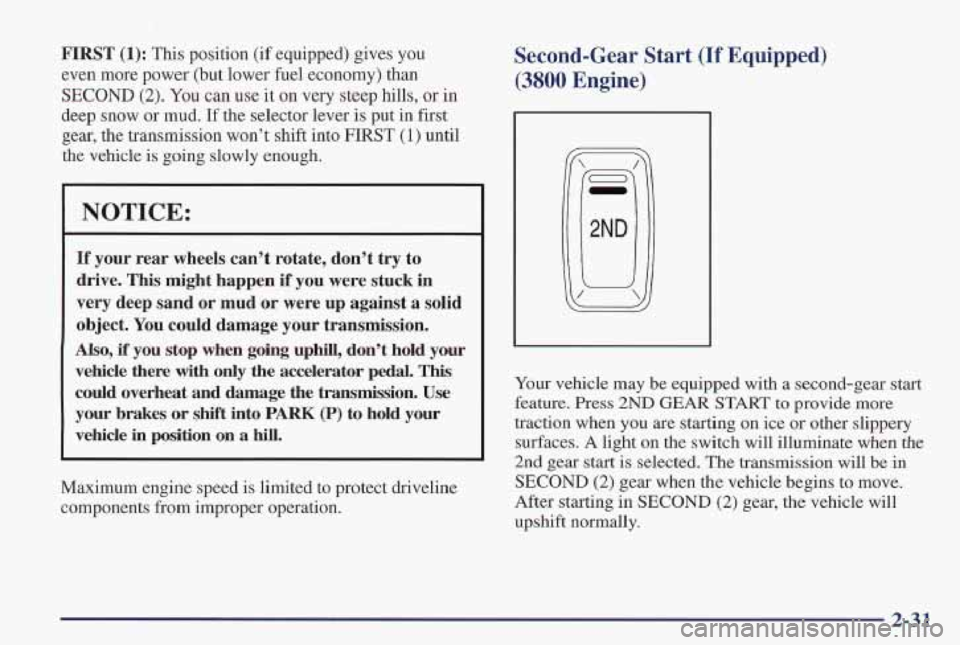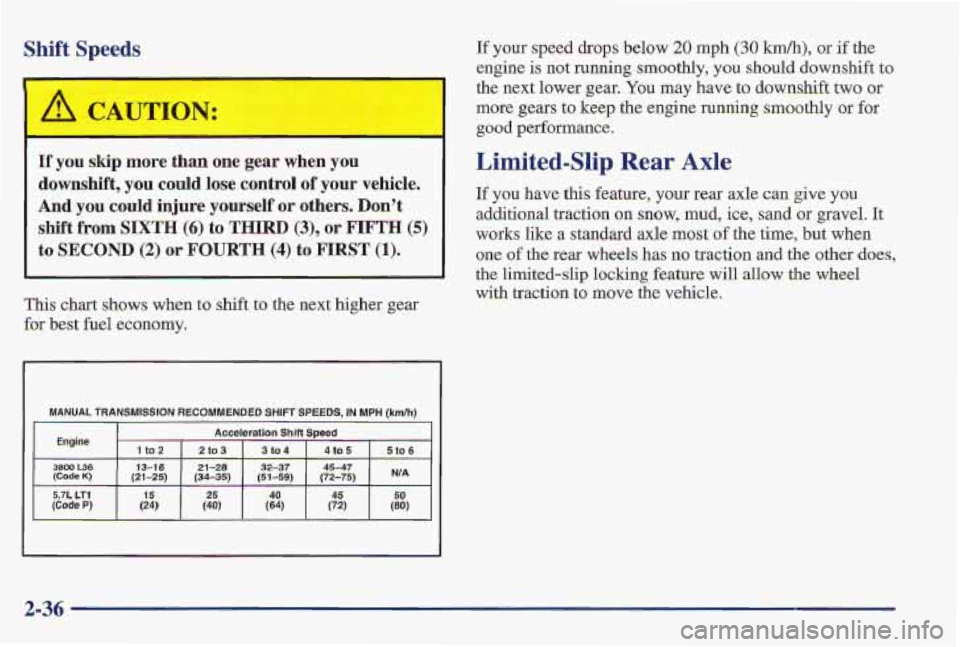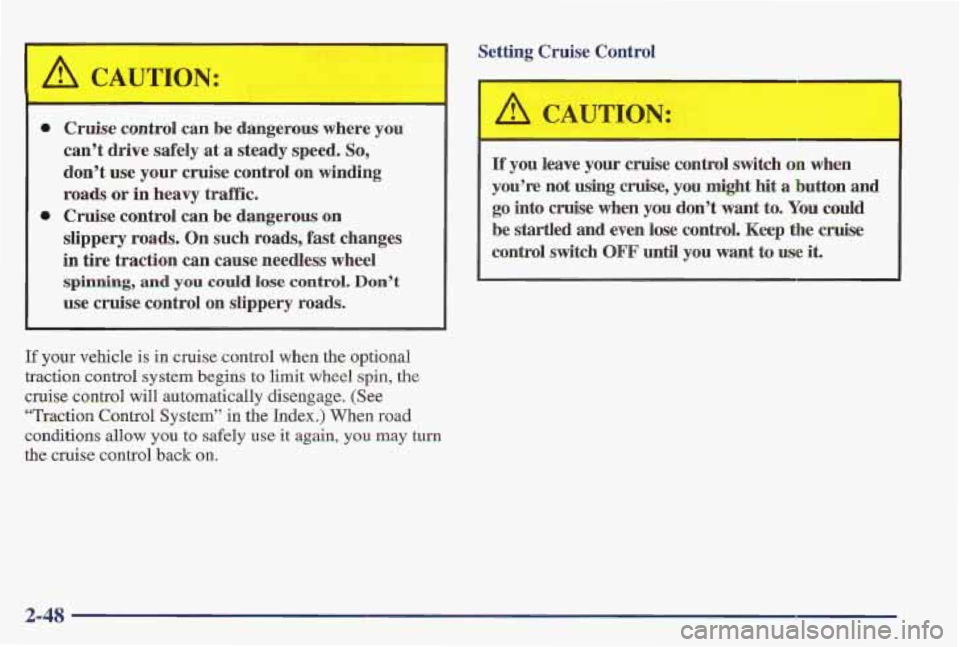wheel PONTIAC FIREBIRD 1997 User Guide
[x] Cancel search | Manufacturer: PONTIAC, Model Year: 1997, Model line: FIREBIRD, Model: PONTIAC FIREBIRD 1997Pages: 410, PDF Size: 19.2 MB
Page 74 of 410

NOTICE:
If your key seems stuck in LOCK and you can’t
turn
it, be sure you are using the correct key; if
so, is it all the way in? If it is, then turn the
steering wheel left and right while you turn the
key hard. But turn the key only with your hand.
Using
a tool to force it could break the key or the
ignition switch. If none of this works, then your
vehicle needs service.
Starting Your Engine
Automatic Transmission
Move your snm lever to PARK (P) or NEUTRAL (N).
Your engine won’t start in any other position -- that’s a
safety feature. To restart when you’re already moving,
use NEUTRAL (N) only.
NOTICE:
~~
Don’t try to shift to PARK (P) if your Pontiac is
moving.
If you do, you could damage the
transmission. Shift to
PARK (P) only when your
vehicle is stopped.
2-25
Page 77 of 410

Automatic Transmission Operation
There are several different positions for your shift lever.
PARK (a): This locks your rear wheels. It’s the best
position
to use when you start your engine because your
vehicle can’t move easily,
It is dangerous to get out of your vehicle if the
shift lever
is not fully in PARK (P) with the
parking brake firmly set. Your
vehicle can roll.
Don’t leave your vehicle when the engine is
running unless you have to. If you have left the
engine running, the vehicle can move suddenly.
You or others could be injured. To be sure your
vehicle won’t move, even when you’re on
fairly
level ground, always set your parking brake and
move the shift lever to PARK (P).
See “Shifting Into PARK (P)” in the Index. If
you’re pulling a trailer, see “Towing a Trailer” in
the Index.
2-28
Page 78 of 410

Ensure the shift lever is fully in PARK (P) range before
starting the engine. Your Pontiac has a
Brake-Transmission Shift Interlock.
You have to fully
apply your regular brakes before you can shift from
PARK
(P) when the ignition key is in the RUN position.
If you cannot shift out of PARK (P), ease pressure on
the shift lever
-- push the shift lever all the way into
PARK (P) and also release the shift lever button on floor
shift console models as
you maintain brake application.
Then move the shift lever into the‘gear you wish. (Press
the shift lever button before moving the shift lever
on
floor shift console models.) See “Shifting Out of
PARK,
(P) in this section.
REVERSE (R): Use this gear to back up.
I NOTICE:
Shifting to REVERSE (R) while your vehicle is
moving forward could damage your
transmission. Shift to
REVERSE (R) only after
your vehicle is stopped.
To rock your vehicle back and forth to get out of snow,
ice or sand without damaging your transmission, see
“Stuck: In Sand, Mud, Ice
or Snow” in the Index.
NEUTRAL (N): In this position, your engine
doesn’t connect with the wheels.
To restart when you’re
already moving, use
NEUTRAL (N) only. Also, use
NEUTRAL (N) when your vehicle is being towed.
A 1
A CAUTION:
Shifting out of PARK (P) or NEUTRAL (N) while
your engine
is “racing” (running at high speed) is
dangerous. Unless your foot is firmly on the
brake pedal, your vehicle could move
very
rapidly. You could lose control and hit people or
objects. Don’t shift out of PARK (P) or
NEUTRAL
(N) while your engine is racing.
NOTICE:
Damage to your transmission caused by shifting
out of PARK
(P) or NEUTRAL (N) with the
engine racing isn’t covered
by you warranty.
2-29
Page 80 of 410

FIRST (1): This position (if equipped) gives you
even more power (but lower fuel economy) than
SECOND (2). You can use it on very steep hills, or in
deep snow or mud. If the selector lever is put in first
gear, the transmission won’t shift into
FIRST (1) until
the vehicle is going slowly enough.
NOTICE:
If your rear wheels can’t rotate, don’t try to
drive. This might happen if you were stuck in
very deep sand or mud or were up against a solid
object. You could damage your transmission.
Also, if you stop when going uphill, don’t hold your
vehicle there
with only the accelerator pedal. This
could overheat and damage the transmission. Use
your brakes or shift into
PARK (P) to hold your
vehicle in position on
a hill.
Maximum engine speed is limited to protect driveline
components from improper operation.
Second-Gear Start (If Equipped)
(3800 Engine)
Your vehicle may be equipped with a second-gear start
feature. Press 2ND GEAR START to provide more
traction when you are starting on ice
or other slippery
surfaces.
A light on the switch will illuminate when the
2nd gear start
is selected. The transmission will be in
SECOND (2) gear when the vehicle begins to move.
After starting
in SECOND (2) gear, the vehicle will
upshift normally.
2-31
Page 85 of 410

Shift Speeds
If pull skip more than one gear waien you
downshift, you could lose control of your vehicle.
And
you could injure yourself or others. Don’t
shift from SIXTH (6) to THIRD (3), or FIFTH (5:
to SECOND (2) or FOURTH (4) to FIRST (1).
This chart shows when to shift to the next higher gear
for best fuel economy.
I MANUAL TRANSMISSION RECOMMENDED SHIFT SPEEDS, IN MPH (kmfh) ,
Engine Acceloratlen Shlft Speed
it02 I 2to3 I 3to4 I 4to5 I St06
(72-75) I N’A 45-47
If your speed drops below 20 mph (30 km/h), or if the
engine is
not running smoothly, you should downshift to
the next lower gear. You may have to downshift two or
more gears to keep the engine running smoothly or for
good performance.
Limited-Slip Rear Axle
If you have this feature, your rear axle can give you
additional traction on snow, mud, ice, sand or gravel. It
works like
a standard axle most of the time, but when
one
of the rear wheels has no traction and the other does,
the limited-slip locking feature will allow the wheel
with traction to move the vehicle.
2-36
Page 92 of 410

Windows
Manual Windows
Rotate the window crank handle to open and close each
door
window.
Power Windows (If Equipped)
With power windows, switches on the door control each
window when
the ignition is on or when RAP is present.
(See “Retained Accessory P’ower’’ in the Index.) You
can open the passenger’s window any amount by
pressing the switch and releasing it when the window
has lowered to the position
you want.
The switch for the driver’s window has an express-down
feature. Quickly press and release the switch for the
driver’s window and the window will lower completely.
You can also open the driver’s window any
amount by
pressing the switch again while the window is in the
express-down mode when
it has lowered to the position
you want.
Horn
To sound the horn, press either horn symbol on your
steering wheel.
If your horn sounds two or three chirps when unlocking
your vehicle with the transmitter (if you have that
option), the alarm was triggered while
you were away.
Check the vehicle before entering.
2-43
Page 93 of 410

Tilt Steering Wheel Thrn SignaVMultifunction Lever
A tilt steering wheel allows you to adjust the steering
wheel before
you drive.
You can also raise it to the highest level to give your
legs more room when
you exit and enter the vehicle.
To tilt the wheel, hold the steering wheel and pull the
lever. Move the steering wheel to
a comfortable level,
then release the lever to lock the wheel in place.
The lever on the left side of the steering column
includes your:
0 Turn Signal and Lane Chaaage Indicator
0 Headlamp HighLow Beam Changer and
Passing Signal
Windshield Wipers
Windshield Washer
Cruise Control (Option)
2-44
Page 97 of 410

Cruise control can be dangerous where you
can’t drive safely at
a steady speed. So,
don’t use your cruise control on winding
roads or in heavy traffic.
slippery roads. On such roads, fast changes
in tire traction can cause needless wheel
spinning, and you cauld lose control. Don’t
use cruise control on slippery roads.
0 Cruise control ‘can be dangerous on
If your vehicle is in cruise control when the optional
traction control system begins to limit wheel spin,
the
cruise control will automatically disengage. (See
“Traction Control System” in the Index.) When road
conditions allow you to safely use it again, you may turn
the cruise control
back on.
Setting Cruise Control
~ ~~~
If you leave your cruise control switch on when
you’re not using cruise, you might
hit a button and
go into cruise when you don’t want to. You could
be startled and even lose control. Keep the cruise
control switch OFF until you want to use it.
2-48
Page 124 of 410

A. Fog Lamp Switch (If Equipped)
B. Main Lamp Control
C. Air Vent
D. Instrument Cluster
E.
Horn
E Audio System
G. Glove Box
H. Comfort Controls
I. Cupholder
J. Parking Brake Lever
K.
Storage Console
L. Rear Window Defogger Switch
M. Convertible Top Switch (Automatic) (If Equipped)
N. Traction Control System Switch or Second Gear
0. Cigarette Lighter
P. Shift Lever
Q. Ashtray (Automatic Transmission)
R. Convertible Top Switch (Manual) (If Equipped)
S. Steering Wheel Controls
T. Remote Hatch Release
Start
Switch (If Equipped)
Page 130 of 410

Traction Control System Warning Light
(If Equipped)
I
Your regular brake system may not be working
properly if the anti-lock brake system warning
light is flashing. Driving with the anti-lock
brake system warning light flashing can lead to
an accident. After you’ve pulled off the road
and stopped carefully, have the vehicle towed
for service.
If the anti-lock brake system warning light stays on
longer than normal after you’ve started your engine, turn
the ignition off. Or, if the light comes on and stays on
when you’re driving, stop as soon as possible and turn
the ignition off. Then start the engine again to reset the
system.
If the light still stays on, or comes on again
while you’re driving, your Pontiac needs service. If the
light is on but not flashing and the regular brake system
warning light isn’t on, you still have brakes, but you
don’t have
anti-lock brakes.
The anti-lock brake system warning light should come
on briefly when you turn the ignition key to RUN. If the
light doesn’t come on then, have it fixed so it will be
ready to warn you if there is a problem.
TCS
OFF
This warning light should
come on briefly as you start
the engine.
If the. warning
light doesn’t come on then,
have it fixed
so it will be
ready to warn you if there’s
a problem.
If it stays on, or comes on when you’re driving, there
may be a problem with your traction control system and
your vehicle may need service. When this warning light
is on, the system will not limit wheel spin. Adjust your
driving accordingly.
If your brakes begin to overheat, the brake portion of the
traction control system will shut down, but the throttle
and engine spark control will continue
to work. The
warning light will not come on when this happens.